Different Types Of Rugs And Their Colors: How To Choose One Which You Need
Selecting the perfect area rug for your room can be more tricky than you think. Like any other decor item, rug selection needs careful planning and selection. An area rug can complete or destroy the beauty of your room. Depending on the material, size, design style, shape, pricing, and type of room, there are many factors you need to consider before choosing the right rug you are looking for.
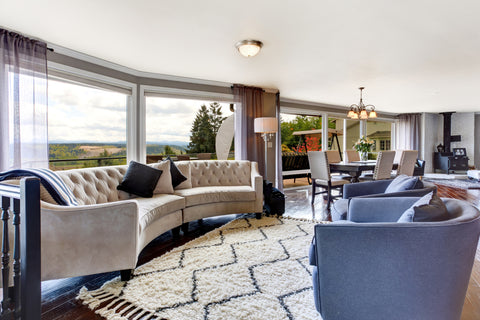
Photo by iriana88w on depositphotos
Choosing the type and color of the rug is a personal choice and should reflect the person’s style and preference. As for the rug types, one can sort them based on the materials, designs, styles, weaves, origins, and budget. Picking the right color for the rug depends mainly on the room color tone, the furniture color, the availability of natural light, and the room type.
Rugs help you dress up your room’s floor. Rugs can bring a cohesive look and completeness to your room by tying up all the elements in your room.
Let’s start exploring and dig in a little deeper to bring home the rug of your dreams.
1. What Is The Best Material For A Living Room Rug?
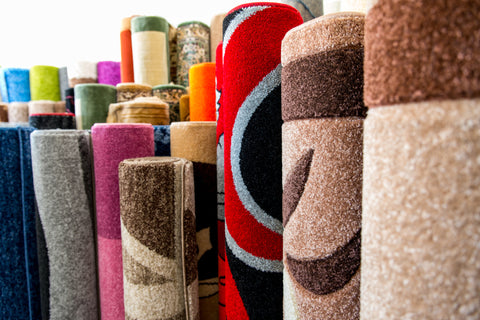
Photo by ibrak on depositphotos
WOOL:
It is the unrivaled choice for the living room rug material. With its flat weave, hand-knotted wool offers your living area a cozy, plush, and luxurious look.
The advantages of choosing a wool rug are soft underfoot, long-lasting, stain-resistant, and an excellent insulator for warm and cold climates.
The only downside of a wool rug is that it is way too expensive.
These long-lasting wool rugs (hand-knotted) are so durable that they are passed down from generation to generation and belong to vintage collectibles, making them worth every penny.
For budget-friendly options, you can consider nylon or polyester rugs.
NYLON:
These rugs mimic the look and feel of silk rugs. They are durable and can withstand wear and tear. They are easy to clean and maintain, hence suitable for busy households. Though they fall in the expensive range of synthetic rug material, they are still economical compared to wool and silk.
The only drawback of nylon rugs is that they are super absorbent and thus prone to mold and mildew growth.
POLYESTER:
It is resistant to fading and staining, thus suitable for high-traffic areas and houses with kids and pets. They offer a soft and plush feel to your feet.
The pros of owning a polyester rug are they are water resistant and dry out far quicker when exposed to accidental spills, making them super friendly for a low-maintenance choice of rug.
They are also a budget-friendly option.
The only drawback is their plastic make, which can make them emit harmful formaldehyde fumes that are proven to be carcinogenic.
JUTE, SISAL AND SEAGRASS:
These natural fiber rugs offer a rustic and textured look to your living space and are also sustainable.
They are long-lasting, thus, suitable for heavy foot traffic areas but are less soft than other rug options. Their versatility makes them ideal for a whole bunch of different spaces in your home.
A jute rug is tough and hardy, sisal is tough, and seagrass has a woody feel. Each rug has a unique and beautiful texture and does a great job hiding dirt underneath them. They last longer when used indoors rather than outdoors.
They are cheap, strong, and since the raw material comes from nature, choosing them is an act of favor towards our planet.
SILK:
The delicate silk rugs, like wool ones, are an expensive choice. Go for a silk rug if you want a sophisticated look and a rich vibe to your living room. They are best suited for low-traffic areas as they are prone to damage.
Other than the fact that they are super expensive, silk rugs are also high maintenance. In fact, keeping them dry, rotating the rug periodically so your rug wears down equally on all sides, and cleaning them with utmost care can prolong the life of your silk rug.
2. Where Do Runner Rugs Go?
Place these long and narrow rugs in a few locations in your home.
a) Entryway: Lay the runner rug in your entryway for decorative purposes and create a welcoming atmosphere. Runner rugs, when placed on the entrance, prevent mud and dirt from getting inside the house and helps keep your home clean.
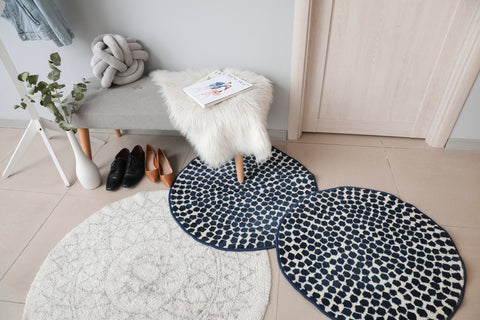
Photo by serezniy on depositphotos
b) Kitchen: Food prep and cooking can be an arduous task requiring you to stand in the kitchen for a very long time. Use runner rugs in your food prep area to provide support, comfort, and cushioning to your tired feet.
Messy food spills and stains are pretty common in kitchens, and with the rug in place, you don’t really have to worry about your floor’s protection.
Consider placing them in front of workstations in your kitchen, such as countertops, kitchen islands, and sinks.
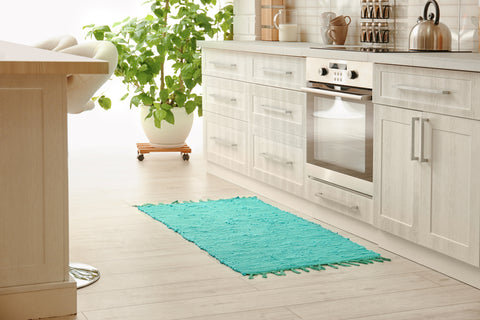
Photo by belchonock on depositphotos
c) Staircases: A runner rug can be a glamorous addition to the stairs in your home, acting as an antislip mat and muffling noises while climbing stairs. Though they protect the stairs from wear and tear, maintaining a stair runner is a tad bit difficult.
Pro-Tip: You should note that stair runner looks good on traditional-styled homes rather than contemporary ones.
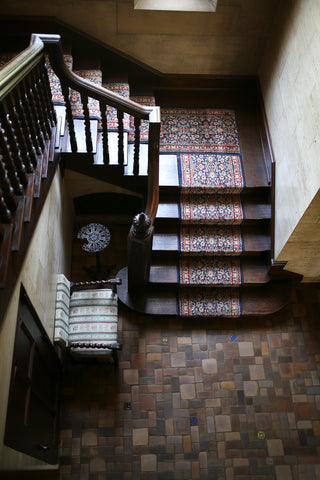
Photo by Christin_Lola on depositphotos
d) Bedroom: When you intend to show off your rug’s beauty without it being buried under the bed, place them at the foot or on the sides of your bed. This way, you can fully display your rug. Additionally, it serves the purpose of providing soft cushioning underfoot when you get out of bed.
You can also go the usual route and choose a rug to place under the bed – 2/3rds from the base of the bed or go all the way up and accommodate the front legs of your night lamp stand – the choice is ultimately yours.
Pro-Tip: Choose a plush and soft rug since the bedroom is a less-treaded, personal space. Shag rugs and high-pile rugs are the best picks for our slumber chambers.
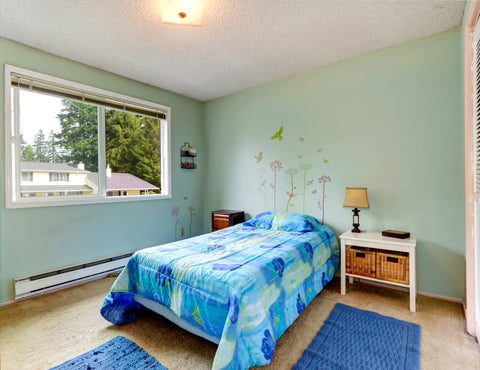
Photo by iriana88w on depositphotos
e) Bathroom: Include runner rugs in your large bathroom in front of the bathtub, shower space, or bathroom vanity to provide grip and protection on the floor next to wet areas. They also add warmth and a cohesive look to your bathroom.
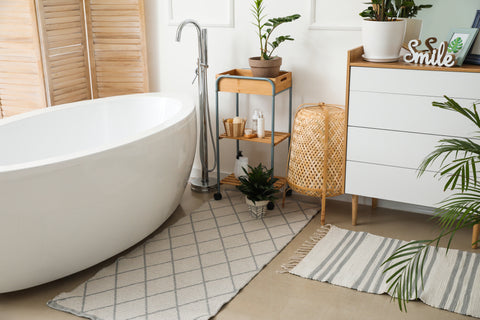
Photo by serezniy on depositphotos
3. Which Type and Color Of Area Rug Best Suits High-Traffic Areas?
The type, color, and design style are of utmost importance in area rugs used in high-traffic areas.
TYPE:
a) Jute or Sisal Rugs: These natural rugs are hardy, stain and spill-resistant, and can
withstand heavy use. They are a practical choice for high-traffic areas to mask footprints, dirt, and debris. Please be aware that this material may not provide a soft feel underfoot. If you want some textural contrast or nature-inspired beauty under your roof, natural rugs are the ideal choice.
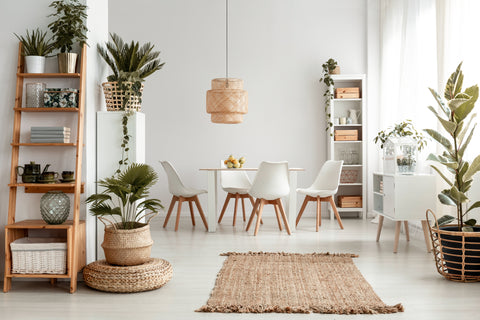
Photo by photographee.eu on depositphotos
b) Wool or Nylon Rugs: Wool rugs may be a high-end option, but nylon is budget-friendly.
Choose flatweave or low pile rugs, which work best for busy areas. This enables you to move around the furniture easily. The smooth surface also helps you walk without tripping. These area rugs are easy to maintain, durable, and less likely to be damaged by constant foot traffic.
Color And Design of the Rug for High-Traffic Areas:
a) Dark Tones: Dark colors, like deep blue, chocolate brown, and charcoal gray, work better in concealing stains, wearing out, and dirt. Medium to dark colors look acceptable for these areas.
b) Multicolored Rugs: Flecked, mottled, dappled, or mosaic patterns can be an excellent choice for high-traffic area rugs. Using multiple colors in a rug help hide stains and dirt and provide a tidier appearance.
c) Patterned Rugs: Intricate designs, geometric patterns, and small-scale motifs best suit this busy area as it effectively camouflages footprints and dirt and is a smart choice for high-traffic areas.
Remember, above all, regular care, cleaning, and maintenance are crucial for the upkeep of high-traffic area rugs.
4. What Are Some Types of Rugs Based On Their Weaves?
Based on the weave construction, the most common types of rugs are:
a) Hand-Knotted Rugs: These rugs are the most expensive for a reason. They are made of superior quality wool or silk, with thousands of knots tied one on top of the other, forming an intricate, rich pattern. These rugs are handwoven artistically by skilled rug weavers, who put in many months of hard work to complete a single rug.
b) Hand-Tufted Rugs: This type of weaving involves using canvas cloth on which wool or silk strands are punched with the help of a tufting tool or a gun to make a pattern. A layer of adhesive or latex is applied on the back of the rug to firmly secure the tufts. Unlike hand-knotted rugs, these can be made in a shorter timeframe and are modestly priced.
c) Braided Rugs: These rustic-looking rugs suit country-style or farmhouse-type homes. Strands of fabric or yarn strips are braided to form long plaits. These plaits are stitched together to create different patterns and shapes of a rug.
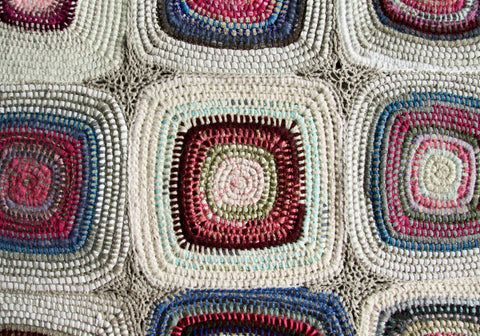
Photo by Svetlanarib79 on depositphotos
One of the pros of using a braided rug is that if one side gets dirty or stained, you can turn it over and use it.
d) Hooked Rugs: These popular handmade rugs are created by pulling loops of yarn or fabric through a backing material using a hooked needle, thus the name hooked rugs. What is eye-catching about hooked rugs is their textured appearance. These beautiful rugs are made with cheerful colors and quirky designs.
They are durable, stylish, and budget-friendly and go well with traditional and modern interior designs.
e) Flatweave Rugs: Dhurries, Kelims, Navajo, Soumak, and Kilims all come under the category of flatweave rugs.
Flatweave rugs, as the name suggests, have no pile but a flat and smooth surface. These flat-woven rugs are made by tightly weaving weft threads through warp threads using a weaving loom.
These rugs usually don’t shed, stand the test of time, and look great even after use. In addition, they can be reversed and used and are economical too.
f) Machine-Woven Rugs: These rugs are mechanically woven in power mills, hence made very quickly.
They are also affordable, durable, and versatile.
Choose your machine-woven rug from a wide range of colors, styles, and designs.
5. How to Choose The Color Of Your Rug?
1. Go Neutral:
Choosing a rug at the end is probably the most difficult thing in your rug-buying process. If you don’t get the intended color for your rug, buy gray, cream, or beige. These colors are so versatile that they blend easily with almost all colors. These timeless colors can be swapped with various decor options.
2. Follow a Color Theme:
When shopping for your rug, consider the different colors in the room – sofa, cushions, wall shade, curtains, etc. Pick out 2-3 theme colors from your room. Choose a rug color that complements these colors.
3. Opposing Hues:
If you have a room filled with peppy colors, choose a slightly toned-down shade for your rug.
But if the room is very drab and plain, accentuate your rug as the focal point by choosing vibrant colors.
4. Size Of Room:
If your room is small, make it look spacious and airy by choosing lighter shades. Choosing a darker shade for a small room will make it look even smaller.
Choose darker rugs for a large room with natural light to create a comfy and intimate aura.
5. Kind Of Room:
Choose softer, calming shades for light traffic areas like bedrooms and lounge areas.
For high-traffic areas such as the hallway or living room, opt for patterned or dark rugs that will mask the stains and dirt.
6. Complement With Patterns:
If you would like to go for a patterned rug, make sure that the pattern complements the other decor features in the room, like the sofa, curtains, and throw pillows.
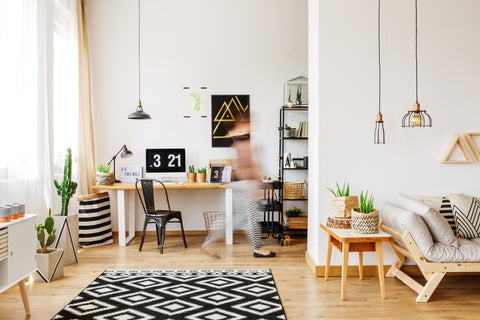
Photo by photographee.eu on depositphotos
If your room is already boldly patterned, then go for a solid color to strike a balance.
Rugs in your living room are a part of the decor element you want to blend perfectly. The material of choice and the color of the rug decides that to a large extent.
So, have fun exploring, experimenting, and choosing the rug of your choice!

